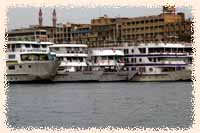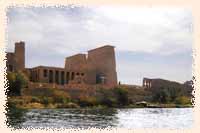










sites/photos
High Dam
Unfinished Obelisk
Kalabsha Temple
Kiosk of Qertassi
Beit el-Wali
Memorial
Philae Temple
Kiosk of Trajan
Nubian Museum
history
greco-romans
Ptolemaic Dynasty
hotel
notes
February 10, 2003:
We have discovered the secret to getting small bills -- rent a luggage cart at the airport. There are no machines, just a gentleman with a herd of metal carts and a staggering wad of one pound bills. Negotiate the price -- two or three pounds is very generous -- and, with much shuffling of feet and smiling, offer a twenty pound note. Explain that it is the smallest you have and you need change. After a awhile, he will confer with the other cart-vendors and reluctantly give you change in small bills. I felt a bit bad about the deception, until Mark pointed out that the vendor still had rolls of small bills. This is a cash economy -- and he had the contacts to change bills that we simply didn't have.
Inundation
 Out very early to Aswan (caught the bus about an hour
before a 7:45 flight. The airport is not busy. We
went immediately to touring with a different guide,
a lovely young woman whose name we simply cannot remember -- Jasmine?.
She had startling violet-tray eyes
. The car was very small and silver. (We later realized
it was her car). She spent most of the time trying to
sit in the sun, as it was maybe 70 degrees and she
was freezing to death. Once again, Mark and I think it's perfect outside, albeit a bit windy.
Out very early to Aswan (caught the bus about an hour
before a 7:45 flight. The airport is not busy. We
went immediately to touring with a different guide,
a lovely young woman whose name we simply cannot remember -- Jasmine?.
She had startling violet-tray eyes
. The car was very small and silver. (We later realized
it was her car). She spent most of the time trying to
sit in the sun, as it was maybe 70 degrees and she
was freezing to death. Once again, Mark and I think it's perfect outside, albeit a bit windy.
First off, a visit to the High Dam, which, despite the hype is quite unimpressive. It's wide, not at all like the dams I'm familiar with (Hoover dam, for example) A lot of the width is packed sand sealed with silt, which supports the concrete interior.
The real impact of dam is realizing its results -- the enormous Lake Nasser and the end to catastrophic flooding in the Nile Valley. For thousands of years, the yearly inundation brought down loads of heavy, rich silt from the upper reaches of the Nile. When the waters receded, they left behind the dark soil in the Nile Valley that supported Egypt's agricultural output and, even more critically, Egyptian culture.
Eliminating the flooding every year did eliminate some of the problems high flood waters and evened out the good and bad years, but it also changed the way that Egyptians farm in a fundamental way. Without the rich influx of silt from above, farmers have to use chemical fertilizers to keep the fields producing; without the annual floods, the land is slowly being reclaimed by the desert unless vast irrigations systems are in place. But, the dam has removed the danger and loss of life of huge floods, and produces enough electricity to supply Cairo. Still, there are many people we talked to who felt it was a huge mistake.
And, of course, there is the loss of hundreds of Nubian temples and other monuments to the depths of Lake Nasser. Some - -like Abu Simbel, Philae, and Kalabsha -- have been saved by UNESCO and moved to higher grounds. Others are gone, deemed too small or unimportant to rescue.
Relocated Temples
Kalabsha is one of the temples that was saved. . We took a ferry to the island and
walked around for an hour or so. IT's small, and much
ruined, but it s was saved in the same way as Abu
Simbel -- dismantled and reconstructed here on a new
site. Also on the same island is the Kiosk of Qertassi, a roman ruin, and the small Beit el-wali temple. It's interesting to note that while the motif of the temple is definitely pharaonic, the work is much more recent -- these are Greco-Romanruins.
 Philae temples are stunning -- the Kiosk of Trajan is probably one of the most memorable sights in Aswan. The entire island was reshaped to move the temple to higher ground and rebuilt it here. On some of the columns, you can see the water-mark from when the temples was submerged for part of the year during the floods. Some of the pictures I've seen show Victorian boaters paddling around between the columns in the hypostyle hall, and swimming in the Kiosk of Trajan when the flood waters were high.
Philae temples are stunning -- the Kiosk of Trajan is probably one of the most memorable sights in Aswan. The entire island was reshaped to move the temple to higher ground and rebuilt it here. On some of the columns, you can see the water-mark from when the temples was submerged for part of the year during the floods. Some of the pictures I've seen show Victorian boaters paddling around between the columns in the hypostyle hall, and swimming in the Kiosk of Trajan when the flood waters were high.
Aswan
A quick stop at the granite quarries and the Unfinished
Obelisk, and we were checking into the Old Cataract
Hotel by one or so. Lovely hotel -- we ate lunch
and then had ice cream on the famous verandah and
then -- predictably --napped.
After a quick nap and dinner, Jasmine picked us up and drove us over to the new Nubian Museum. She and her brother picked us up in her little silver car. Her brother, George, would be our guide for the next day. We would be riding camels, she explained, and she wasn't up to it. I should have taken that as an omen.
 The museum
is gorgeous. A huge outdoor gallery of sculpture surrounds the building, which contains a well-thought-out collection of Nubian artifacts and pharaonic piece from Aswan. Many of the pieces were relocated here from the Egyptian Museum in Cairo.
The museum
is gorgeous. A huge outdoor gallery of sculpture surrounds the building, which contains a well-thought-out collection of Nubian artifacts and pharaonic piece from Aswan. Many of the pieces were relocated here from the Egyptian Museum in Cairo.
On the way back to the hotel we stopped at the Coptic Cathedral -- which is a giant open building decorated with distinctive Coptic icons. Both our guide and her brother were Copts -- which explained why she wore no scarf. Aswan has a large population of Coptic Christians.